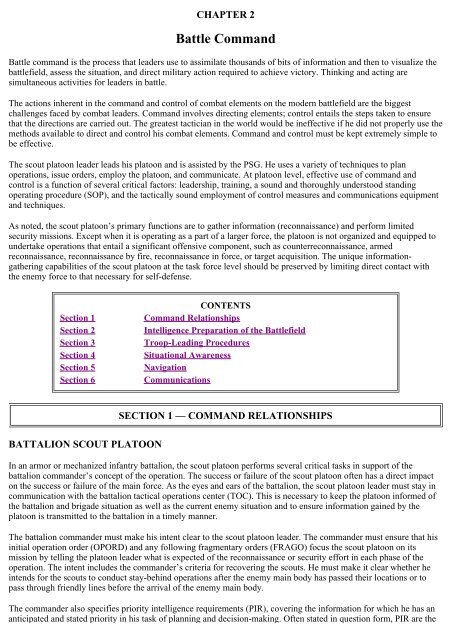FM 17-98 SCOUT PLATOON
FM 17-98 SCOUT PLATOON
FM 17-98 SCOUT PLATOON
You also want an ePaper? Increase the reach of your titles
YUMPU automatically turns print PDFs into web optimized ePapers that Google loves.
CHAPTER 2<br />
Battle Command<br />
Battle command is the process that leaders use to assimilate thousands of bits of information and then to visualize the<br />
battlefield, assess the situation, and direct military action required to achieve victory. Thinking and acting are<br />
simultaneous activities for leaders in battle.<br />
The actions inherent in the command and control of combat elements on the modern battlefield are the biggest<br />
challenges faced by combat leaders. Command involves directing elements; control entails the steps taken to ensure<br />
that the directions are carried out. The greatest tactician in the world would be ineffective if he did not properly use the<br />
methods available to direct and control his combat elements. Command and control must be kept extremely simple to<br />
be effective.<br />
The scout platoon leader leads his platoon and is assisted by the PSG. He uses a variety of techniques to plan<br />
operations, issue orders, employ the platoon, and communicate. At platoon level, effective use of command and<br />
control is a function of several critical factors: leadership, training, a sound and thoroughly understood standing<br />
operating procedure (SOP), and the tactically sound employment of control measures and communications equipment<br />
and techniques.<br />
As noted, the scout platoon’s primary functions are to gather information (reconnaissance) and perform limited<br />
security missions. Except when it is operating as a part of a larger force, the platoon is not organized and equipped to<br />
undertake operations that entail a significant offensive component, such as counterreconnaissance, armed<br />
reconnaissance, reconnaissance by fire, reconnaissance in force, or target acquisition. The unique informationgathering<br />
capabilities of the scout platoon at the task force level should be preserved by limiting direct contact with<br />
the enemy force to that necessary for self-defense.<br />
Section 1<br />
Section 2<br />
Section 3<br />
Section 4<br />
Section 5<br />
Section 6<br />
CONTENTS<br />
Command Relationships<br />
Intelligence Preparation of the Battlefield<br />
Troop-Leading Procedures<br />
Situational Awareness<br />
Navigation<br />
Communications<br />
SECTION 1 — COMMAND RELATIONSHIPS<br />
BATTALION <strong>SCOUT</strong> <strong>PLATOON</strong><br />
In an armor or mechanized infantry battalion, the scout platoon performs several critical tasks in support of the<br />
battalion commander’s concept of the operation. The success or failure of the scout platoon often has a direct impact<br />
on the success or failure of the main force. As the eyes and ears of the battalion, the scout platoon leader must stay in<br />
communication with the battalion tactical operations center (TOC). This is necessary to keep the platoon informed of<br />
the battalion and brigade situation as well as the current enemy situation and to ensure information gained by the<br />
platoon is transmitted to the battalion in a timely manner.<br />
The battalion commander must make his intent clear to the scout platoon leader. The commander must ensure that his<br />
initial operation order (OPORD) and any following fragmentary orders (FRAGO) focus the scout platoon on its<br />
mission by telling the platoon leader what is expected of the reconnaissance or security effort in each phase of the<br />
operation. The intent includes the commander’s criteria for recovering the scouts. He must make it clear whether he<br />
intends for the scouts to conduct stay-behind operations after the enemy main body has passed their locations or to<br />
pass through friendly lines before the arrival of the enemy main body.<br />
The commander also specifies priority intelligence requirements (PIR), covering the information for which he has an<br />
anticipated and stated priority in his task of planning and decision-making. Often stated in question form, PIR are the











